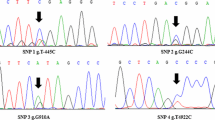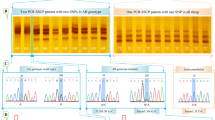Abstract
The aim of this study was to assess the potential of 21 bp mutation in the second intron of the GSN gene as a molecular marker-assisted by exploring the effect of 21 bp mutation on growth traits in four beef cattle breeds. Gelsolin (GSN), a member of the superfamily of gel proteins, is involved in the regulation of a variety of cellular activities in the organism and plays an important function in cell motility, apoptosis, signal transduction and inflammatory responses. Gelatin can not only negatively regulate the pro-apoptotic effect of P53 protein, but also promote apoptosis by blocking the interaction between actin and deoxyribonuclease, so, the GSN gene was selected as a candidate gene in this study. In this study, a 21 bp mutation on the second intron to the GSN gene was verified in 573 individuals of Yunling (YL, n = 220), Jiaxian (JX, n = 140), Xianan (XN, n = 114) and Qinchuan (QC, n = 97) cattle breeds using Once PCR and agarose gel electrophoresis. The association analysis of polymorphisms in the GSN gene with growth traits in four breeds was revealed: in YL cattle, the heart girth and forehead size of heterozygous ID genotype were significantly higher than II genotype (P < 0.05). In JX cattle, the withers height, body length and heart girth of II and ID genotype were significantly highest than DD genotype (P < 0.01); the height at hip cross and height at sacrum of II genotype was significantly highest than DD genotype (P < 0.01), but ID genotype was significantly higher than DD genotype. In XN cattle, the abdominal girth and circumference of the cannon bone of II genotype were significantly higher than ID genotype (P < 0.05). In QC cattle, the hucklebone width of ID genotype was significantly the highest than II genotype (P < 0.01). The results suggest that GSN may be an important candidate gene and that a 21 bp mutation on the second intron to the GSN gene can be used for molecular marker-assisted selection of four beef cattle breeds.


Similar content being viewed by others
References
Bicknell AA, Cenik C, Chua HN, Roth FP, Moore MJ (2012) Introns in UTRs: why we should stop ignoring them. BioEssays 34:1025–1034
Bucki R, Georges PC, Espinassous Q, Funaki M, Pastore JJ, Chaby R, Janmey PA (2005) Inactivation of endotoxin by human plasma gelsolin. Biochemistry 44(28):9590–9597
Cui Y, Yan H, Ke W, Xu H, Zhang X, Zhu H et al (2018) Insertion/deletion within the KDM6A gene is significantly associated with litter size in goat. Front Genet 9:91
Deng R, Hao J, Han W, Ni Y, Huang X, Hu Q (2015) Gelsolin regulates proliferation, apoptosis, migration and invasion in human oral carcinoma cells. Oncol Lett 9(5):2129
Ferlaino M, Rogers MF, Shihab HA, Mort M, Cooper DN, Gaunt TR, Campbell C (2017) An integrative approach to predicting the functional effects of small indels in non-coding regions of the human genome. BMC Bioinformatics 18:442
Gao J, Qin Z, Guan X, Guo J, Wang H, Liu S (2017) Overexpression of GSN could decrease inflammation and apoptosis in EAE and may enhance vitamin D therapy on EAE/MS. Rep 7(1):604
Hardy GH (1908) Mendelian proportions in a mixed population. Science 28(706):49–50
Hirko AC, Meyer EM, King MA, Hughes JA (2007) Peripheral transgene expression of plasma gelsolin reduces amyloid in transgenic mouse models of Alzheimer’s disease. Mol Ther 15(9):1623–1629
Jacob AG, Smith C (2017) Intron retention as a component of regulated gene expression programs. Hum Genet 136(9):1043–1057
Jun Y, Dongfeng T et al (2004) Prognostic significance of gelsolin expression level and variability in non-small cell lung cancer—ScienceDirect. Lung Cancer 46(1):29–42
Li GH, Arora PD, Chen Yu, McCulloch CA, Liu P (2012) Multifunctional roles of gelsolin in health and diseases. Medi R Rev 32(5):999–1025
Li J, Erdenee S, Zhang S, Wei Z, Zhang M, Jin Y et al (2018) Genetic effects of PRNP gene insertion/deletion (indel) on phenotypic traits in sheep. Prion 12(1):42–53
Martínez R, Gómez Y, Rocha J (2014) Genome-wide association study on growth traits in Colombian creole breeds and crossbreeds with Zebu cattle. Genet Mol Res 13(3):6420–6432
Memon S, Li G, Xiong H, Wang L, Liu X, Yuan M et al (2018) Deletion/insertion polymorphisms of the prion protein gene (PRNP) in gayal (Bos frontalis). J Genet 97:1131–1138
Nag S, Ma Q, Hui W, Chumnarnsilpa S, Wei LL, Larsson M et al (2009) Ca2+ binding by domain 2 plays a critical role in the activation and stabilization of gelsolin. Proc Natl Acad Sci USA 106(33):13713–13718
Nei MA, Roychoudhury AK (1974) Sampling variances of heterozygosity and genetic distance. Genetics 76(2):379–390
Ohtsu M (2014) Inhibition of apoptosis by the actin-regulatory protein gelsolin. Embo J 16(15):4650–4656
Oikonomou N, Thanasopoulou A, Tzouvelekis A, Harokopos V, Paparountas T, Nikitopoulou I et al (2009) Gelsolin expression is necessary for the development of modelled pulmonary inflammation and fibrosis. Thorax 64(6):467
Orlovskaya OA, Vakula SI, Khotyleva LV, Kilchevsky AV (2018) Association between total carotenoid content of Maize Kernels (Zea mays L.) and polymorphic site INDEL1 in PSY1 gene. Russ J Genet Appl Res 8(1):74–79
Rouayrenc JF, Fattoum A, Gabrion J, Audemard E, Kassab R (1984) Muscle gelsolin: isolation from heart tissue and characterization as an integral myofibrillar protein. FEBS Lett 167(1):52–58
Sadeghi MM, Shariati L, Hejazi Z, Shahbazi M, Tabatabaiefar MA, Khanahmad H (2018) Inducing indel mutation in the SOX6 gene by zinc finger nuclease for gamma reactivation: an approach towards gene therapy of beta thalassemia. J Cell Biochem 119(3):2512–2519
Sambrock J, Russel DW (2001) Molecular cloning: a laboratory manual, 3rd edn. Cold Spring Harber Laboratory Press, America
Sham P, Bader JS, Craig I, O’Donovan M, Owen M (2002) DNA pooling: a tool for large-scale association studies. Nat Rev Genet 3(11):862–871
Sun H, Lin K, Yin L (1997) Gelsolin modulates phospholipase C activity in vivo through phospholipid binding. J Cell Biol 138(4):811–820
Wang Z, Zhang X, Jiang E, Yan H, Zhu H, Chen H et al (2020) InDels within caprine IGF2BP1 intron 2 and the 3′-untranslated regions are associated with goat growth traits. Anim Genet 51(1):117–121
Wei X, Hua H, Li Z, Xu JW, Lei CZ, Zhang GM, Hong C (2018) Detection of 19-bp deletion within PLAG1 gene and its effect on growth traits in cattle. Gene 675:144–149
Wigginton JE, Cutler DJ, Abecasis GR (2013) Report a note on exact tests of Hardy-Weinberg Equilibrium. Am J Hum Genet 76(887–883):2005
Wittmann J, Dieckow J, Schröder H, Hampel U, Garreis F, Jacobi C et al (2018) Plasma gelsolin promotes re-epithelialization. Sci Rep 8(1):13140
Xue J, Sun Y, Guo W, Yang Z, Tian H, Zhang C et al (2013) Haplotypes and effects on growth traits of bovine Wnt7a gene in Chinese Qinchuan cattle. Gene 524(2):241–245
Yeh YL, Ting WJ, Shen CY, Hsu HH, Chung LC, Tu CC et al (2016) Hypoxia augments increased HIF-1α and reduced survival protein p-Akt in Gelsolin (GSN)-dependent cardiomyoblast cell apoptosis. Cell Biochem Biophys 74(2):221–228
Yin HL, Stossel TP (1979) Control of cytoplasmic actin gel|[ndash]|sol transformation by gelsolin, a calcium-dependent regulatory protein. Nature 281(5732):583–586
Yongliang F, Ziyin H, Idriss AAA, Yi Y, Zhangping Y (2020) Effect of aging time on meat quality of longissimus dorsi from yunling cattle: a new hybrid beef cattle. Animals 10(10):1897
Zhang B, Zhao G, Lan X, Lei C, Zhang C, Chen H (2012) Polymorphism in GHRH gene and its association with growth traits in Chinese native cattle. Res Vet Sci 92(2):243–246
Zhang Q, Jin Y, Jiang F, Cheng H, Wang Y, Lan X, Song E (2019) Relationship between an indel mutation within the SIRT4 gene and growth traits in Chinese cattle. Anim Biotechnol 30:352–357
Zhang Y, Luo X, Lin J, Fu S, Deng W (2020) Gelsolin promotes cancer progression by regulating epithelial-mesenchymal transition in hepatocellular carcinoma and correlates with a poor prognosis. J Oncol 2020(11):1–10
Zhou H, Lai Li, Dang. (2019) The distribution characteristics of a 19-bp Indel of the PLAG1 gene in Chinese Cattle. Animals 9(12):1082
Zhuoyu C, Kaifei L, Xiaofeng Y et al (2019) Lower Expression of gelsolin in colon cancer and its diagnostic value in colon cancer patients. J Cancer 10:1288–1296
Acknowledgements
This work was supported by the Program of National Beef Cattle and Yak Industrial Technology System (no. CARS-37), the Program of Yunling Scholar and the Young and Middle-aged Academic Technology Leader Backup Talent Cultivation Program in Yunnan Province, China (no. 2018HB045), Yunnan Provincial Major S&T Project (2019ZG007, 2019ZG011). The Agricultural Improved Seed Project of Shandong Province (2020LZGC014-03).
Author information
Authors and Affiliations
Corresponding authors
Ethics declarations
Conflict of interest
All authors have no any actual or potential conflict of interest including any financial, personal or other relationships with other people or organizations within three years of beginning the submitted work that could inappropriately influence, or be perceived to influence, their work.
Additional information
Communicated by Joan Cerda.
Publisher's Note
Springer Nature remains neutral with regard to jurisdictional claims in published maps and institutional affiliations.
Supplementary Information
Below is the link to the electronic supplementary material.
Rights and permissions
About this article
Cite this article
Qi, A., Ru, W., Liu, Y. et al. Deletions in GSN gene associated with growth traits of four Chinese cattle breeds. Mol Genet Genomics 297, 1269–1275 (2022). https://doi.org/10.1007/s00438-022-01915-0
Received:
Accepted:
Published:
Issue Date:
DOI: https://doi.org/10.1007/s00438-022-01915-0




